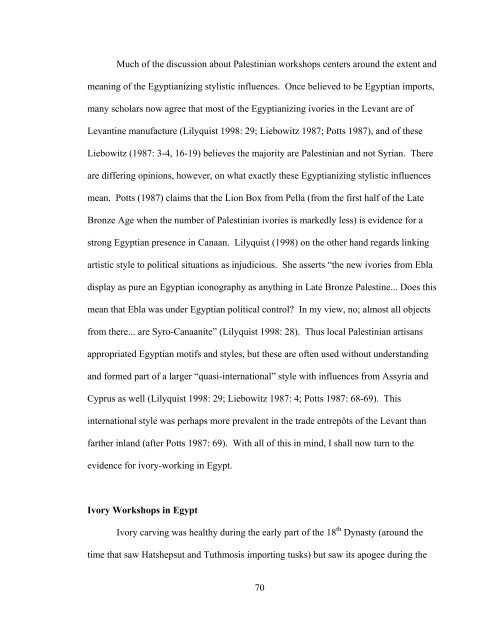Tracing the Source of the Elephant And Hippopotamus Ivory from ...
Tracing the Source of the Elephant And Hippopotamus Ivory from ...
Tracing the Source of the Elephant And Hippopotamus Ivory from ...
Create successful ePaper yourself
Turn your PDF publications into a flip-book with our unique Google optimized e-Paper software.
Much <strong>of</strong> <strong>the</strong> discussion about Palestinian workshops centers around <strong>the</strong> extent and<br />
meaning <strong>of</strong> <strong>the</strong> Egyptianizing stylistic influences. Once believed to be Egyptian imports,<br />
many scholars now agree that most <strong>of</strong> <strong>the</strong> Egyptianizing ivories in <strong>the</strong> Levant are <strong>of</strong><br />
Levantine manufacture (Lilyquist 1998: 29; Liebowitz 1987; Potts 1987), and <strong>of</strong> <strong>the</strong>se<br />
Liebowitz (1987: 3-4, 16-19) believes <strong>the</strong> majority are Palestinian and not Syrian. There<br />
are differing opinions, however, on what exactly <strong>the</strong>se Egyptianizing stylistic influences<br />
mean. Potts (1987) claims that <strong>the</strong> Lion Box <strong>from</strong> Pella (<strong>from</strong> <strong>the</strong> first half <strong>of</strong> <strong>the</strong> Late<br />
Bronze Age when <strong>the</strong> number <strong>of</strong> Palestinian ivories is markedly less) is evidence for a<br />
strong Egyptian presence in Canaan. Lilyquist (1998) on <strong>the</strong> o<strong>the</strong>r hand regards linking<br />
artistic style to political situations as injudicious. She asserts “<strong>the</strong> new ivories <strong>from</strong> Ebla<br />
display as pure an Egyptian iconography as anything in Late Bronze Palestine... Does this<br />
mean that Ebla was under Egyptian political control? In my view, no; almost all objects<br />
<strong>from</strong> <strong>the</strong>re... are Syro-Canaanite” (Lilyquist 1998: 28). Thus local Palestinian artisans<br />
appropriated Egyptian motifs and styles, but <strong>the</strong>se are <strong>of</strong>ten used without understanding<br />
and formed part <strong>of</strong> a larger “quasi-international” style with influences <strong>from</strong> Assyria and<br />
Cyprus as well (Lilyquist 1998: 29; Liebowitz 1987: 4; Potts 1987: 68-69). This<br />
international style was perhaps more prevalent in <strong>the</strong> trade entrepôts <strong>of</strong> <strong>the</strong> Levant than<br />
far<strong>the</strong>r inland (after Potts 1987: 69). With all <strong>of</strong> this in mind, I shall now turn to <strong>the</strong><br />
evidence for ivory-working in Egypt.<br />
<strong>Ivory</strong> Workshops in Egypt<br />
<strong>Ivory</strong> carving was healthy during <strong>the</strong> early part <strong>of</strong> <strong>the</strong> 18 th Dynasty (around <strong>the</strong><br />
time that saw Hatshepsut and Tuthmosis importing tusks) but saw its apogee during <strong>the</strong><br />
70

















